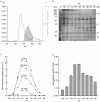Cell-cycle inhibition by Helicobacter pylori L-asparaginase
- PMID: 21085483
- PMCID: PMC2976697
- DOI: 10.1371/journal.pone.0013892
Cell-cycle inhibition by Helicobacter pylori L-asparaginase
Erratum in
- PLoS One. 2012;7(2). doi: 10.1371/annotation/c6c16a43-aadd-4cd3-a916-e935534dab38 doi: 10.1371/annotation/c6c16a43-aadd-4cd3-a916-e935534dab38
Abstract
Helicobacter pylori (H. pylori) is a major human pathogen causing chronic gastritis, peptic ulcer, gastric cancer, and mucosa-associated lymphoid tissue lymphoma. One of the mechanisms whereby it induces damage depends on its interference with proliferation of host tissues. We here describe the discovery of a novel bacterial factor able to inhibit the cell-cycle of exposed cells, both of gastric and non-gastric origin. An integrated approach was adopted to isolate and characterise the molecule from the bacterial culture filtrate produced in a protein-free medium: size-exclusion chromatography, non-reducing gel electrophoresis, mass spectrometry, mutant analysis, recombinant protein expression and enzymatic assays. L-asparaginase was identified as the factor responsible for cell-cycle inhibition of fibroblasts and gastric cell lines. Its effect on cell-cycle was confirmed by inhibitors, a knockout strain and the action of recombinant L-asparaginase on cell lines. Interference with cell-cycle in vitro depended on cell genotype and was related to the expression levels of the concurrent enzyme asparagine synthetase. Bacterial subcellular distribution of L-asparaginase was also analysed along with its immunogenicity. H. pylori L-asparaginase is a novel antigen that functions as a cell-cycle inhibitor of fibroblasts and gastric cell lines. We give evidence supporting a role in the pathogenesis of H. pylori-related diseases and discuss its potential diagnostic application.
Conflict of interest statement
Figures





References
-
- Nomura A, Stemmermann GN, Chyou PH, Kato I, Perez-Perez GI, et al. Helicobacter pylori infection and gastric carcinoma among Japanese Americans in Hawaii. N Engl J Med. 1991;325:1132–1136. - PubMed
-
- Parsonnet J, Friedman GD, Vandersteen DP, Chang Y, Vogelman JH, et al. Helicobacter pylori infection and the risk of gastric carcinoma. N Engl J Med. 1991;325:1127–1131. - PubMed
-
- Honda S, Fujioka T, Tokieda M, Satoh R, Nishizono A, et al. Development of Helicobacter pylori-induced gastric carcinoma in Mongolian gerbils. Cancer Res. 1998;58:4255–4259. - PubMed
-
- Wacker P, Land VJ, Camitta BM, Kurtzberg J, Pullen J, et al. Allergic Reactions to E. coli L-Asparaginase Do Not Affect Outcome in Childhood B-precursor Acute Lymphoblastic Leukemia: A Children's Oncology Group Study. J Pediatr Hematol Oncol. 2007;29:627–632. - PubMed
Publication types
MeSH terms
Substances
LinkOut - more resources
Full Text Sources
Molecular Biology Databases

